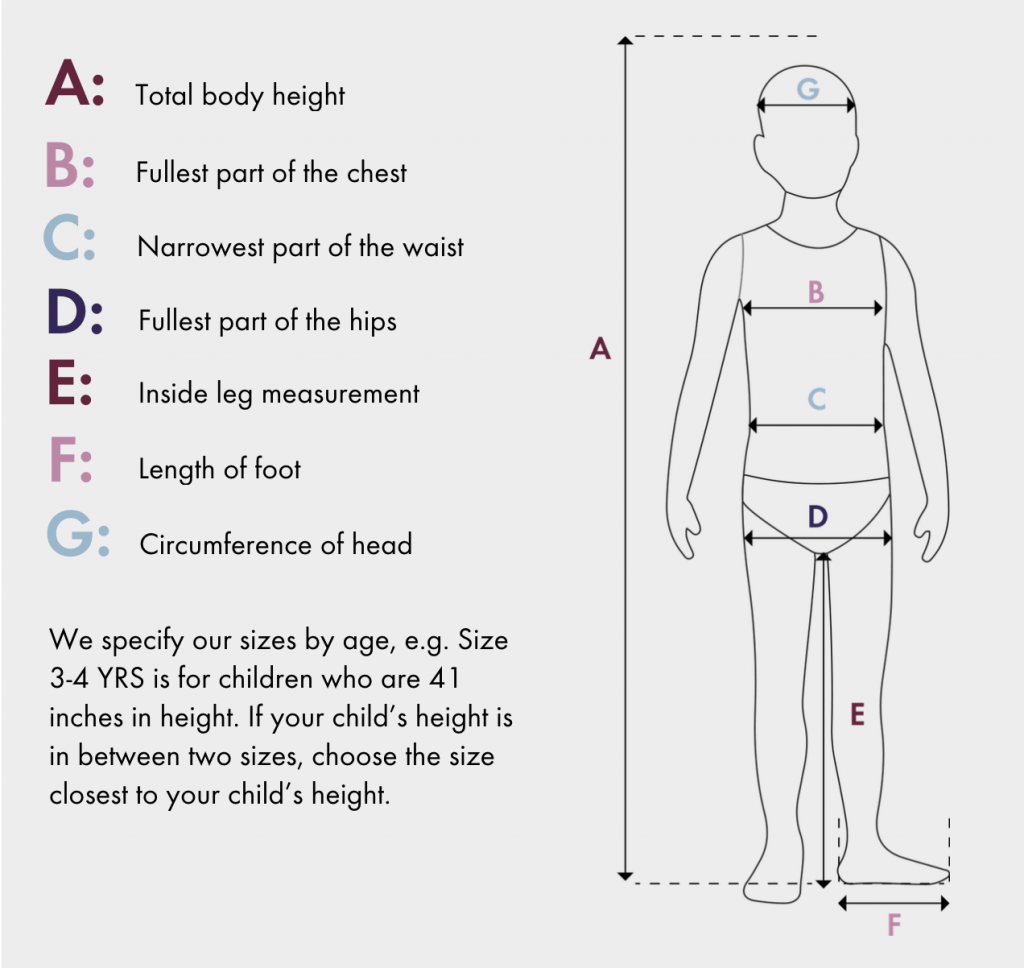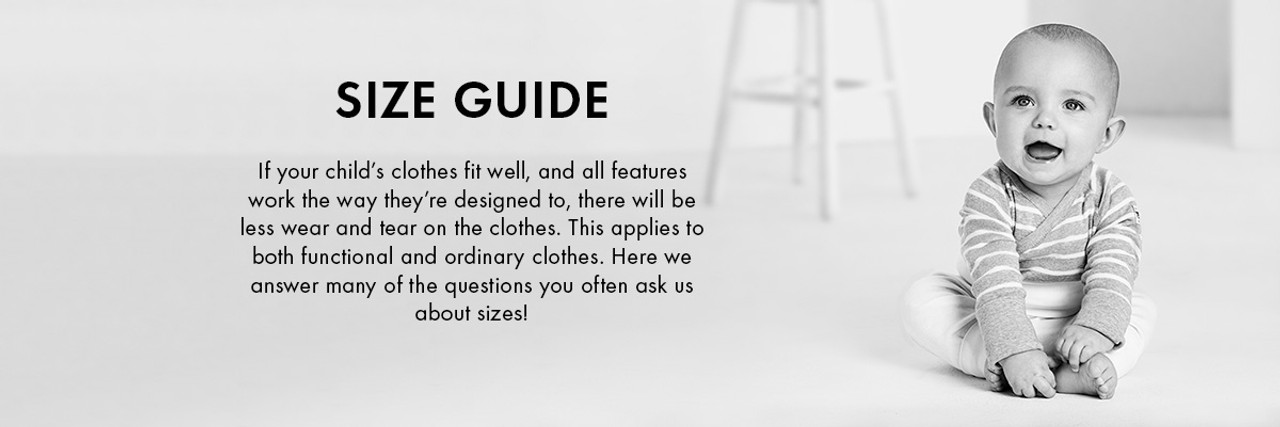Sizing Guide
Posted by Your friends at PO.P! on Dec 10, 2019
Find the right size
Simply measure your child’s height to find the right size for them. But keep in mind that children tend to have growth spurts, so always use an up-to-date measurement. Your child’s height in inches tells you which clothing size you need. We specify ages next to each size as a rough guide if it’s not possible to measure their height. But always measure if you have the chance to do so.
How should the item fit?
When choosing ordinary clothes, be guided by what feels most comfortable for your child. Make sure that your child can move freely, and that no part of the item feels tight or chafes. The ends of the sleeves should not be too short or hang down over your child’s fingers. The ends of ordinary trousers should not be too short; nor should your child tread on them when they walk. And the crotch should not hang down too low and prevent your child from running freely.


How to test the fit of outerwear clothing:
Jacket:
- Ask your child to lift their arms straight up. The cuffs should still cover their wrists when they do.
- You should be able to grasp a generous amount of material at the lower back of the jacket. This shows you that there’s room for Layers 1 & 2.
Trousers/overall:
- Ask your child take a few big steps. They should easily be able to do this.
- The reflectors on the legs should be clearly visible.
- Your child should not be treading on the ends of the trousers when they walk.
- Ask your child to kneel down. The ends of the trousers should stay level with the top of their feet when they kneel and there should be no tightness around their hips.
- Tugging the shoulders of an overall should not make it feel tight at the crotch.
- You should be able to grasp a generous amount of material at the back of the trousers. This shows you that there’s room for Layers 1 & 2.
FAQs about baby clothes:
Which size should I buy before my baby is born?
While we can’t give a definite answer, we generally recommend that you buy a few items in size 0-1 Month, one or two in size Preemie and one or two in size 1-2 Months. If you keep the original tags on, any item that’s too small can be returned after your baby arrives (a full refund is available for 14 days). And any item that’s too big will fit your baby eventually.
Which size should a windproof fleece bunting be?
Your baby needs enough room to wear 2-3 layers underneath. Our buntings give your baby plenty of growing room. You can fold over the sleeves and leg cuffs at first. When this is no longer possible, you can add mittens and booties so that your baby can get more wear out of the bunting. But a bunting is too small if it’s tight, or there are gaps at the legs or sleeves. Important! It is not safe for a baby to wear a thick or bulky bunting in their car seat – it creates too wide a gap between the baby’s body and the safety harness!
Which size hat should I choose?
A hat should not leave any marks on your baby’s forehead and you should easily be able to slide two fingers under the edge. The hat should cover your baby’s ears. If the hat starts sliding up, it’s too small. If you plan to buy a hat before your baby is born, our sizes are usually a good match to a baby’s age.
Which size booties should I choose?
We usually recommend choosing the smallest size at first. But if your baby’s toes are pressing against the front of the booties, they are too small. If booties tend to fall off in the pram, our mitten clips can help to keep them in place!
Which size socks should I choose?
Socks should stay up, the heel should remain in place and the fabric should not be too tight. A very young baby’s socks will rarely need washing, so two pairs in size 0-1 Month and two in size 1-2 Months are a good start if you’re buying before your baby is born.
Our soft ribbed socks for newborns stay on your baby’s feet and are hugely popular
FAQs about outerwear:
Which size outerwear clothing should my child have?
Simply measure your child’s height to find the right size for them. But keep in mind that children tend to have growth spurts, so always use an up-to-date measurement. Your child’s height in inches tells you which clothing size you need. We specify ages next to each size as a rough guide if it’s not possible to measure their height. But height is a better guide than age when finding the right size, as all children are different!
My child is the exact height for one size, e.g. 43 inches, so which size should I choose?
You should choose that size – size 4-5 YRS in this case.
My child is in between sizes, so which size should I choose?
We usually recommend buying the larger size, as children have growth spurts and can suddenly grow a few inches.
How should a jacket fit?
Ask your child to lift their arms straight up. The cuffs should still cover their wrists when they do. Always use the Velcro fastening at the cuffs to hold the sleeves in place: if you turn the sleeves up, the jacket will no longer be waterproof. You should be able to grasp a generous amount of material at the lower back to double-check that there’s room for Layers 1 & 2. The seasons are long and your child needs plenty of growing room.
How should trousers fit?
Your child should find it easy to take some big steps. The reflectors on the legs should be clearly visible. Your child should not be treading on the ends of the trousers when they walk. When your child kneels, the ends of the trousers should stay level with the top of their feet and there should be no tightness around the hips. The seasons are long and your child needs plenty of growing room.
How should an overall fit?
Your child should find it easy to take some big steps. The reflectors on the legs should be clearly visible. Your child should not be treading on the ends of the trousers when they walk. When your child kneels, the ends of the trousers should stay level with the top of their feet and there should be no tightness around the hips. Tugging the shoulders of an overall should not make it feel tight at the crotch. You should be able to grasp a generous amount of material at the lower back to double-check that there’s room for Layers 1 & 2. The seasons are long and your child needs plenty of growing room.
How should a hat fit?
A hat should not leave any marks on your child’s forehead and you should easily be able to slide two fingers under the edge. The hat should cover your child’s ears. If the hat starts sliding up, it’s too small. Our sizes are usually a good match to your child’s age.
How should gloves fit?
Your child’s fingertips should not be pressing against the gloves or their hands will be cold. Gloves should fit well so your child can easily move their hands. Remember that manufacturers have different size measurements for the gloves and mittens they make.
How should a balaclava/neck warmer fit?
Choose the same hat size that your child wears. They should neither be too tight nor hang down.
FAQs about swimwear:
Which size swimwear items should my child have?
Our swimwear sizes are the same as our ordinary clothes. Simply measure your child’s height to find the right size for them. But keep in mind that children tend to have growth spurts, so always use an up-to-date measurement. Your child’s height in inches tells you which clothing size you need. We specify ages next to each size as a rough guide if it’s not possible to measure their height. But height is a better guide than age when finding the right size, as all children are different!
How should UV clothes fit?
It doesn’t matter if UV clothes are close or loose fitting – as long as they cover the required parts of your child’s body, they will provide effective UV protection. So choose the size that feels most comfortable.
How tightly should a swim nappy fit?
If your child is wearing swim shorts with a drawstring waist, you can fasten it firmly enough to suit your child. Then the actual nappy does not need to fit too tightly. Fasten it firmly enough so no poo can leak from the nappy, but no tighter than that. The drawstring may leave slight marks on your child’s body, but there should be no redness on their legs or tummy.
Other FAQs:
How are PO.P’s clothes sized?
We have recently updated our sizes, after your customer feedback that our sizing was too generous. So there should now be a better match between our sizes and the ages of most children. But as there is no global standard to follow, the sizes of all manufacturers will vary. This is why we always recommend that your child tries on the item before you buy it, or that you retain the original tags so you can get a full refund if it doesn’t fit.
Can you skip sizes?
It’s completely up to you – as long as the garment fits your child well. Just make sure that your child can move freely and that they are not treading on the ends of their trousers for example, because of the risk of tripping and unnecessary fraying.
How do your adult sizes fit?
We use standard sizes in our adult range, so choose your normal size.
If you have any other questions about sizes, you’re always most welcome to contact our customer service team and our in-store sales assistants!
